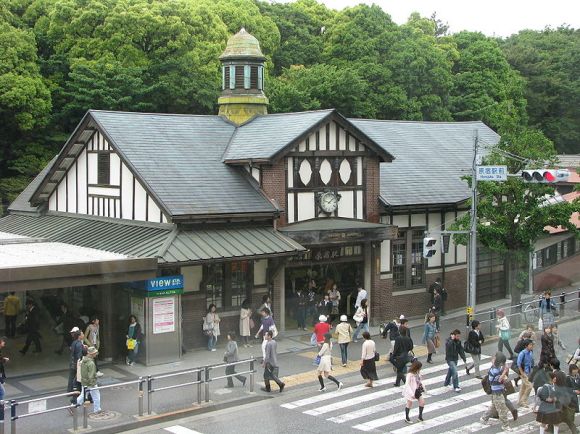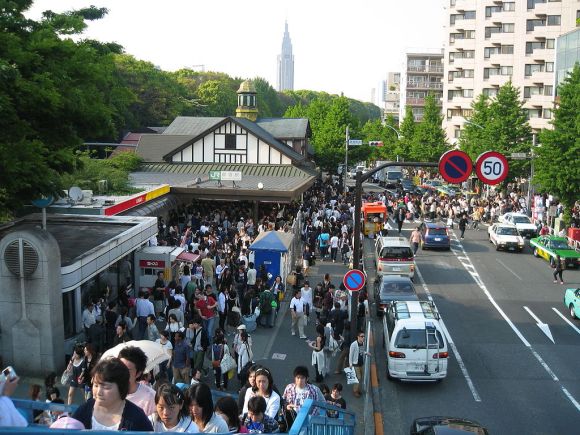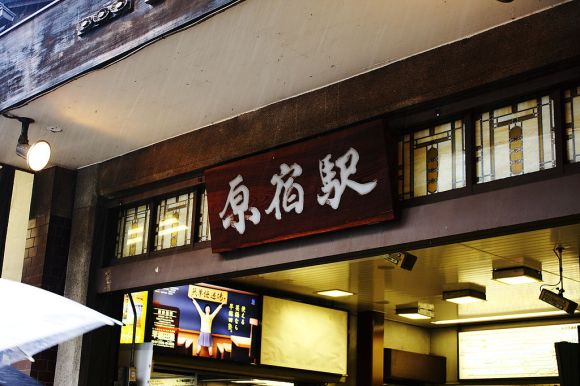
East Japan Railway Company today released images of new building designs planned for three stations on two of the city’s popular train lines.
JR East confirmed reports today that it would be renovating three stations on its Tokyo rail network, with upgrades planned for Harajuku Station on the Yamanote loop line and Sendagaya and Shinanomachi stations on the company’s Chūō-Sobu Line. The works, which will include the introduction of new barrier-free facilities and expansion of concourses and ticket gates, are expected to be completed by 2020 at a total cost of 250 billion yen (US$2.3 billion).
The new plans are designed to improve passenger flow, which is expected to increase dramatically during the 2020 Tokyo Olympics and Paralympics, and alleviate congestion, which, especially in the case of Harajuku Station, can prove dangerous as passengers spill out onto the road from the narrow walkway during peak periods on weekends and public holidays.
The new design planned for Harajuku Station involves the construction of a modern-looking two-storey building above the existing tracks. The temporary platform currently used to accommodate large numbers during special events like New Year’s Day, will now become a new platform for the outer tracks, while a new entrance will be built on the Meiji Jingu side of the station.
Inside, there will be a brand new, wider concourse and ticket gate area, along with elevators and new, more spacious amenities.
▼ The building plan sets out the changes in more detail.
The new-look Sendagaya Station, located close to the National Stadium and Tokyo Gymnasium, will convert an existing temporary platform into a permanent structure for the exclusive use of Shinjuku-bound trains.
Ticket gates will be relocated to accommodate the change and improve passenger flow while doors on platform barriers will be improved to increase security. There will also be upgrades to elevators and amenities.
Shinanomachi Station will receive new doors on platform barriers and new amenities and elevators.
Following the announcement of the station upgrades, Japanese television news reports focused heavily on the changes planned for Harajuku Station. Built in 1924, the wooden building is the oldest of its kind in the Tokyo area, and has a distinctive facade that evokes an atmosphere of nostalgia within its modern environment.
▼ JR East has said it will make a decision on whether to demolish the current structure or incorporate it into the new design after listening to views from the local municipality.
While the new plans will provide much-needed improvements to passenger flow ahead of the 2020 Tokyo Olympics and Paralympic Games, many people in Japan will be sad to say goodbye to the old building if it does have to go.
Follow Oona on Twitter for more information on news and events in Tokyo.
Source: East Japan Railway Company
Top Image: Wikimedia Commons/Chris 73
Insert Images: East Japan Railway Company








 Harajuku Station will be demolished after the Tokyo Olympics and Paralympics
Harajuku Station will be demolished after the Tokyo Olympics and Paralympics Construction start date announced for rebuilding of Tokyo’s iconic Harajuku Station
Construction start date announced for rebuilding of Tokyo’s iconic Harajuku Station Harajuku Station’s beautiful old wooden building is set to return, with a new complex around it
Harajuku Station’s beautiful old wooden building is set to return, with a new complex around it Video shows final moment for Harajuku Station as Tokyo landmark closes after 96 years in service
Video shows final moment for Harajuku Station as Tokyo landmark closes after 96 years in service Dramatic scenes at Harajuku Station as Typhoon Mindulle makes landfall in Japan
Dramatic scenes at Harajuku Station as Typhoon Mindulle makes landfall in Japan Japanese beef bowl chain Sukiya’s 2026 Smile Box lucky bag basically pays for itself
Japanese beef bowl chain Sukiya’s 2026 Smile Box lucky bag basically pays for itself Play games, learn, and get your fortune at Ginza’s limited-time Tsunaguu “Shrine of the Future”
Play games, learn, and get your fortune at Ginza’s limited-time Tsunaguu “Shrine of the Future” Hayao Miyazaki says Happy New Year to Studio Ghibli fans with new art for Year of the Horse
Hayao Miyazaki says Happy New Year to Studio Ghibli fans with new art for Year of the Horse Should you dip your cake in sake? One Japanese brewer says no, but actually yes【 Taste test】
Should you dip your cake in sake? One Japanese brewer says no, but actually yes【 Taste test】 Should you warm up your convenience store onigiri rice balls in the microwave?【Taste test】
Should you warm up your convenience store onigiri rice balls in the microwave?【Taste test】 TeamLab Planets: Walk up a waterfall and catch koi fish at new digital art museum in Tokyo
TeamLab Planets: Walk up a waterfall and catch koi fish at new digital art museum in Tokyo That time Seiji called JASRAC to ask why he didn’t get paid royalties for his song being on TV
That time Seiji called JASRAC to ask why he didn’t get paid royalties for his song being on TV Hand-drawn Godzilla poster used at tiny Taiwanese movie theatre is beautiful in its own way
Hand-drawn Godzilla poster used at tiny Taiwanese movie theatre is beautiful in its own way Ice cream in fried tofu? Taste-testing ice cream inari, a substitute for ice cream cones【Taste test】
Ice cream in fried tofu? Taste-testing ice cream inari, a substitute for ice cream cones【Taste test】 Japan considering raising international traveler departure tax even more than previously reported
Japan considering raising international traveler departure tax even more than previously reported Starbucks Japan ready to get Year of the Horse started with adorable drinkware and plushies【Pics】
Starbucks Japan ready to get Year of the Horse started with adorable drinkware and plushies【Pics】 7 great places to see Mt. Fuji from without having to climb it
7 great places to see Mt. Fuji from without having to climb it We found possibly the quietest Japanese-style hotel in Tokyo’s bustling Shinjuku district
We found possibly the quietest Japanese-style hotel in Tokyo’s bustling Shinjuku district Cup Noodle tries an authentic Jiro-style ramen, but something’s not quite right
Cup Noodle tries an authentic Jiro-style ramen, but something’s not quite right Hello Kitty Choco Egg figures are an adorable trip through three periods of Japanese pop culture【Pics】
Hello Kitty Choco Egg figures are an adorable trip through three periods of Japanese pop culture【Pics】 Japan’s oldest largetooth sawfish in captivity back on display in Mie Prefecture
Japan’s oldest largetooth sawfish in captivity back on display in Mie Prefecture Cyberpunk anime meets traditional culture in Ghost in the Shell gold leaf Japanese changing screens
Cyberpunk anime meets traditional culture in Ghost in the Shell gold leaf Japanese changing screens The best Starbucks Japan Frappuccinos we want to drink again in 2026
The best Starbucks Japan Frappuccinos we want to drink again in 2026 We revisited Sweets Paradise after a decade to see if Japan’s dessert buffet still delivers
We revisited Sweets Paradise after a decade to see if Japan’s dessert buffet still delivers 7-Eleven Japan starts new temporary luggage storage service in over 300 branches
7-Eleven Japan starts new temporary luggage storage service in over 300 branches Disillusionment at Tsukiji’s tourist-target prices led us to a great ramen restaurant in Tokyo
Disillusionment at Tsukiji’s tourist-target prices led us to a great ramen restaurant in Tokyo Starbucks teams up with 166-year-old Kyoto doll maker for Year of the Horse decorations【Photos】
Starbucks teams up with 166-year-old Kyoto doll maker for Year of the Horse decorations【Photos】 Tokyo considering law requiring more trash cans following litter increase in heavily touristed area
Tokyo considering law requiring more trash cans following litter increase in heavily touristed area Tokyo’s Tsukiji sushi neighborhood asks tour groups to stay away for the rest of the month
Tokyo’s Tsukiji sushi neighborhood asks tour groups to stay away for the rest of the month Tokyo event lets you travel back in time, for free, to celebrate 100 years since Showa era start
Tokyo event lets you travel back in time, for free, to celebrate 100 years since Showa era start Sanrio theme park in Japan announces plans to expand into a Sanrio resort
Sanrio theme park in Japan announces plans to expand into a Sanrio resort Japan may add Japanese language proficiency, lifestyle classes to permanent foreign resident requirements
Japan may add Japanese language proficiency, lifestyle classes to permanent foreign resident requirements Stamina-destroying “Paralysis Noodles” are Tokyo’s newest over-the-top ramen innovation
Stamina-destroying “Paralysis Noodles” are Tokyo’s newest over-the-top ramen innovation Survey asks foreign tourists what bothered them in Japan, more than half gave same answer
Survey asks foreign tourists what bothered them in Japan, more than half gave same answer Japan’s human washing machines will go on sale to general public, demos to be held in Tokyo
Japan’s human washing machines will go on sale to general public, demos to be held in Tokyo Japan’s deadliest food claims more victims, but why do people keep eating it for New Year’s?
Japan’s deadliest food claims more victims, but why do people keep eating it for New Year’s? We deeply regret going into this tunnel on our walk in the mountains of Japan
We deeply regret going into this tunnel on our walk in the mountains of Japan Studio Ghibli releases Kodama forest spirits from Princess Mononoke to light up your home
Studio Ghibli releases Kodama forest spirits from Princess Mononoke to light up your home Major Japanese hotel chain says reservations via overseas booking sites may not be valid
Major Japanese hotel chain says reservations via overseas booking sites may not be valid Put sesame oil in your coffee? Japanese maker says it’s the best way to start your day【Taste test】
Put sesame oil in your coffee? Japanese maker says it’s the best way to start your day【Taste test】 No more using real katana for tourism activities, Japan’s National Police Agency says
No more using real katana for tourism activities, Japan’s National Police Agency says Starbucks Japan reveals new sakura drinkware collection, inspired by evening cherry blossoms
Starbucks Japan reveals new sakura drinkware collection, inspired by evening cherry blossoms Updated cherry blossom forecast shows extra-long sakura season for Japan this year
Updated cherry blossom forecast shows extra-long sakura season for Japan this year What should Tokyo’s newest rail station be called? Poll asks high school girls for their opinion
What should Tokyo’s newest rail station be called? Poll asks high school girls for their opinion Yamanote Line train temporarily suspended after carriage fills with smoke in Tokyo
Yamanote Line train temporarily suspended after carriage fills with smoke in Tokyo Shinkansen breaks down, causes all-day commuter chaos at Tokyo Station
Shinkansen breaks down, causes all-day commuter chaos at Tokyo Station The Station Idol Latch! project gifts us with 30 male idols for 30 Yamanote Line stations
The Station Idol Latch! project gifts us with 30 male idols for 30 Yamanote Line stations Platform 13½ set to open at Ueno Station in Tokyo
Platform 13½ set to open at Ueno Station in Tokyo What is this weird train spotted at a Japanese railway station?
What is this weird train spotted at a Japanese railway station? A video visit to Doai, one of Japan’s most terrifying train stations【Video】
A video visit to Doai, one of Japan’s most terrifying train stations【Video】 Want to choose the name of Tokyo’s most important new station? Here’s your chance!
Want to choose the name of Tokyo’s most important new station? Here’s your chance! Tokyo’s busiest train stations have a new, free, English-compatible navigation app
Tokyo’s busiest train stations have a new, free, English-compatible navigation app Tokyo train operator begins issuing body cameras, but it’s not employee conduct that worries them
Tokyo train operator begins issuing body cameras, but it’s not employee conduct that worries them Japan’s tap-to-pay Suica train card system aims to go tapless with walk-through gates, location data scans
Japan’s tap-to-pay Suica train card system aims to go tapless with walk-through gates, location data scans Tokyo’s busiest commuter line slowing things down with special one-lap Yamanote sightseeing train
Tokyo’s busiest commuter line slowing things down with special one-lap Yamanote sightseeing train JR East to introduce numbering system at all stations in Tokyo
JR East to introduce numbering system at all stations in Tokyo Tokyo trains set to become less convenient with new last train schedule
Tokyo trains set to become less convenient with new last train schedule Japan’s train travel soundscape faces sad change as JR East axes special station departure melodies
Japan’s train travel soundscape faces sad change as JR East axes special station departure melodies
Leave a Reply